Video Tutorial: How to Use SEMRush
In this example we are using the website b2w.tv and using SEMrush we will be looking at insights that will help us understand the domain better. When you put the domain into the URL bar there are two things you have to pay attention to – the first being that the page is Domain Overview, and the second being that you have selected the right database to crawl for analysis. In the case of b2w.tv, we are looking at the US database, but there are multiple other country options you can look at for domain reporting if needed.
Domain Overview
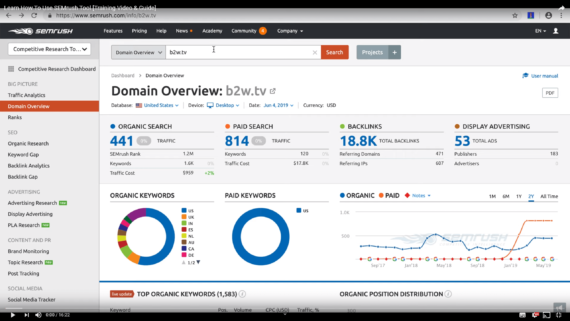
The Domain Overview will then show you relevant domain statistics for that database, with information on Organic Search, Paid Search, Back links, Display Advertising, Organic Keywords by location, Paid Keywords and Organic Position Distribution.
A quick glance shows us that the site has recently massively increased the spending on paid searches, as indicated both the Paid Search number and the orange line in the Organic and Paid graph. The overview also clearly shows that the site hasn’t had much increase in traffic in two years, with a few periods of higher search ranking around May of 2018 and 2019. Discovering what has happened around these times of relatively higher traffic can be a first step to helping a site achieve better search ranking and traffic.
Keep in mind that this information is not necessarily accurate. I’ve done a lot of studies on traffic for clients I know or have access to through their Google Analytics, and when compared it to similar tools like SEMrush, Alexa or something similar the results were sometimes accurate and sometimes extremely inaccurate, under reporting traffic as much as -80% or over predicting traffic by as much as 150%. There is a massive range for discrepancy, so you have to take the numbers with a grain of salt without outside confirmation.
Organic Position Distribution
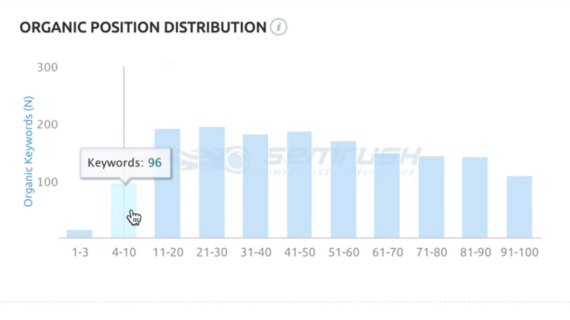
One of my favourite parts of the overview is the Organic Position Distribution. This shows the first 100 positions – the first 10 pages of Google – and how many keywords the database has discovered that rank on Google. This is important because it shows us what opportunities there are for this particular domain. Anything which is not on the first page of Google – positions 1-3 which are above the fold and positions 4-10 which are below the fold – is not driving traffic to the site.
The Organic Position Distribution in the case of b2w.tv shows us that there are about 110 keywords that are driving traffic and over 1000 that aren’t really doing anything. If you can understand what these keywords are and create strategies to drive them towards the first page you can massively increase traffic flow.
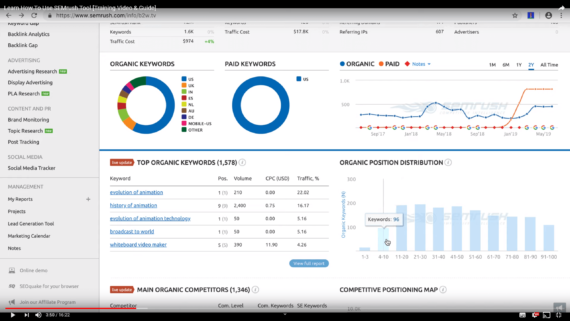
To the left of the Organic Position Distribution is a list of the top five Organic Keywords that are driving traffic to the site. The number one keyword, “evolution of animation” has a monthly search volume of 210 and accounts for 22% of traffic to the site. Using these stats we can also predict monthly site traffic. Having a search volume of 210 and assuming a click-through rate of about 30% for this first position keyword you can assume about 30-60 clicks.
Competitive Positioning Map
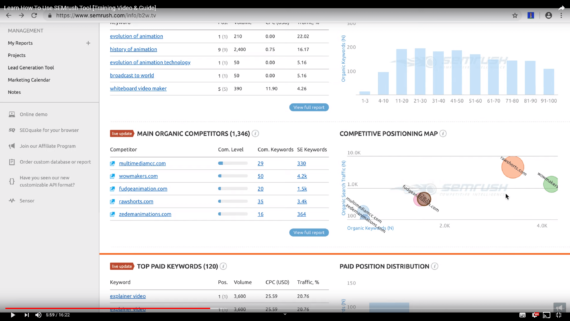
The Competitive Positioning Map shows the sites that are competitors on keyword rankings and how they are performing in relation to your domain. As the graph shows, b2w.tv is sitting around 1.6k keywords and 445 traffic. Their biggest competitor, rawshorts.com has far more well ranking keywords with 3.4k and 4.6k traffic.
Organic Keywords
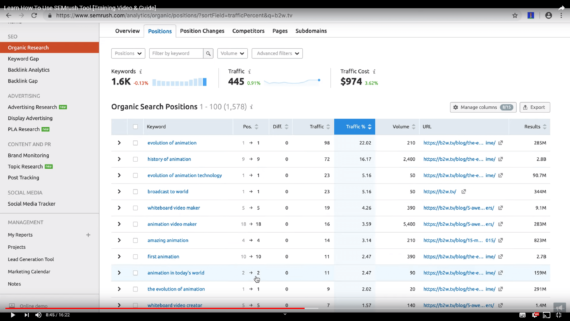
After I look at the overview, I then like to take a closer look at the Organic Keywords. You can sort these results by Search Volume, showing the number of Google searches for that particular term. In the case of b2w.tv, the top result is “animation video maker”. This is a relatively high volume search term with 5400 monthly searches but unfortunately the domain only ranks as position 18 on Google so there is very little traffic coming from the term, with it delivering only 16 clicks. If we can increase the positioning on Google the keyword will drive a lot more traffic.
By sorting the results by Traffic you can see which searches are actually delivering concrete results. The first ten or so results account for about 70% of traffic and here we can identify some avenues to increase the performance of some keywords. The keyword, “cartoon animation maker”, has about 2900 searches a month but the site is only on page 3 of Google so there is very little traffic coming through. “Whiteboard video maker” is also a good opportunity. B2w.tv ranks at 5 for the term – the first page of Google. There are about 390 searches a month for the keyword, so improving rankings will allow b2w.tv to grab more traffic from that search.
On the other hand, the keyword “commercial maker” has a decent volume but I’m not entirely sure what it means in this context. What I’d usually do in a case like this is go to Google and do a search on that term to find the type of websites that appear, because if the first page searches aren’t related to video creation then it may not be a keyword ripe for pursuing.
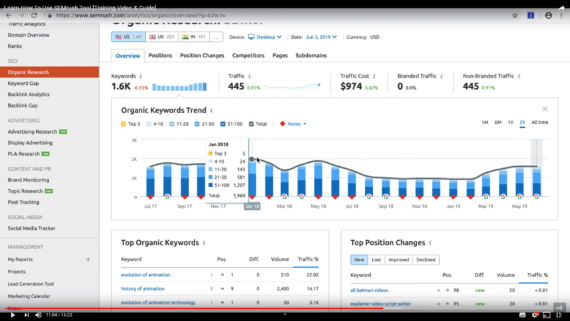
Clicking on Overview in the Organic Keywords bring up a graph showing the number of keywords ranking and the traffic trend for those keywords.
Organic Competitors
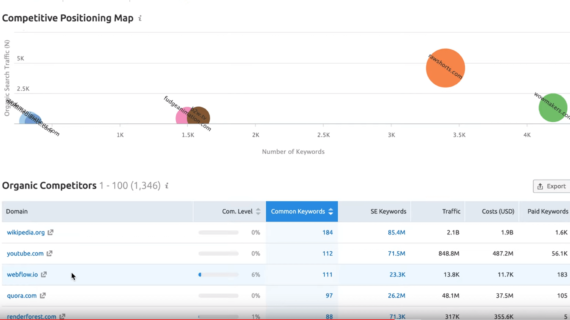
The Organic Competitors list can be used to show both relative positioning among competitors but also their keyword usage. Keep in mind that there may be some entries in the list that aren’t actual competitors but instead simply share some keywords. In this instance, the number one competitor of b2w.tv is listed as Wikipedia as it will most likely have all of the keywords that b2w.tv uses and will rank higher, but since it doesn’t actually make videos, we can safely ignore it. Similarly we can rule out Quora and YouTube.
Rawshorts.com is the most direct competitor by the looks of the graph. If we click on it the domain is added to the URL bar and we can then look at the Estimated Traffic Trend and keywords that are driving traffic. In the case of rawshorts.com, a lot of traffic seems to be coming from their branding, so that’s not much use. Their third largest traffic driver, “animation maker”, has definite possibilities for b2w.tv. Rawshorts.com ranks at 29 on Google and is getting around 111 clicks from the search. “Animation maker” has a high search volume with around 74000 searches a month. If b2w.tv can get “animation maker” ranking high it could drive a lot of traffic their way. Other search terms like “promo video maker” and “whiteboard animator” also offer opportunities.
Keyword Research
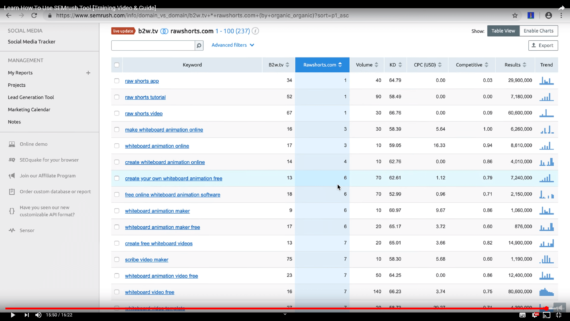
Under Organic Research you can find the Keyword Gap tool. With this tool you can look at all of the keywords used by the domain you’re analysing and competitors. Choosing to search all keywords is best practise when looking for opportunities. Searching by common keywords allows you to see how you are performing compared to a competitor on shared keywords. This can be used to identify possible avenues to either pursue or abandon depending on your positioning and the strength of the rivals position.
These are only a few of the tools available in SEMrush, but it should give you a good overview on how it can be used for analysis of organic keywords on a domain. If you have any questions, post them in the comments below and I’ll answer them as soon as possible.
